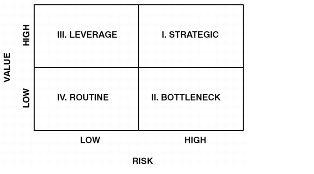All commodity purchases are pertinent to SCM, facilitate the achievement of Postal Service objectives, and can be mapped to a quadrant analysis (see Figure 7.1). This “quadrant analysis” is different from the “quadrant approach” used throughout the rest of these Supplying Practices. The quadrant approach classifies all Postal Service purchases into four categories, depending on their impact on Postal Service core competencies (noncore versus core) and complexities (standard versus custom). The quadrant approach assists in identifying key considerations for various practices in each of the four categories. The quadrant analysis below identifies commodities according to value and risk, and determines the most appropriate SM strategies.
The quadrant analysis tool was developed by Postal Service SCM Strategies to assist commodity teams in performing quadrant analysis and to standardize the analysis process across the entire SM organization. This tool provides a list of questions that serve as the criteria for evaluating each commodity. Based on the inputs provided by the user, the tool performs a weighted calculation to determine the overall relative value and risk of each commodity and graphs the results on a quadrant chart. Category strategies must consider the value and risk of commodities. For example, a low-value / low-risk item is treated with routine planning and does not require the attention and line of attack that a high-value / high-risk item requires.
Value is the relative importance of the commodity to the Postal Service. Factors in assessing value include:
Risk is the degree of supply challenge. Factors in assessing risk include:
Figure 7.1
Quadrant Analysis

Strategic commodities are characterized by complex specifications, few qualified supply sources, and typically large individual expenditures. The quality of these products/services is critical. These commodities tend to be highly important to profitability and operations.
Bottleneck commodities have characteristics that include complex specifications requiring complex manufacturing or service processes, few alternate products available, and few qualified sources of supply. These commodities may impact ongoing operations or maintenance or may involve new technology or untested processes.
Leverage commodities include high expenditure levels, many alternative products/services, numerous suppliers, and readily available sources of supply.
Routine commodities include many existing alternate products/services, many sources of supply, relatively low value items, and many small individual transactions that are easily purchased. These commodities are often items of everyday use.
